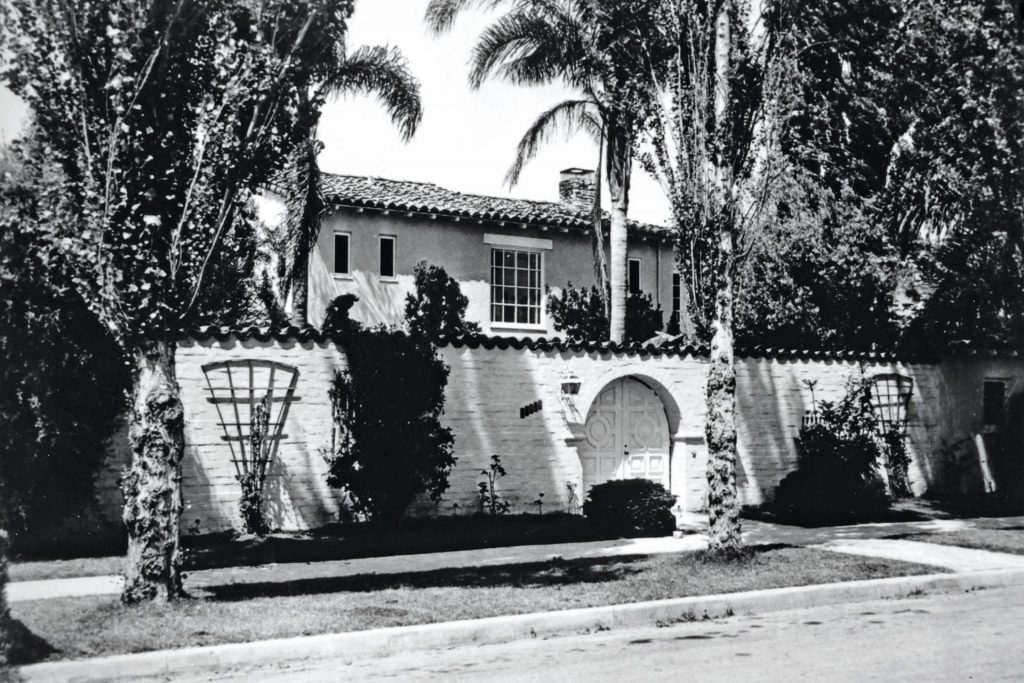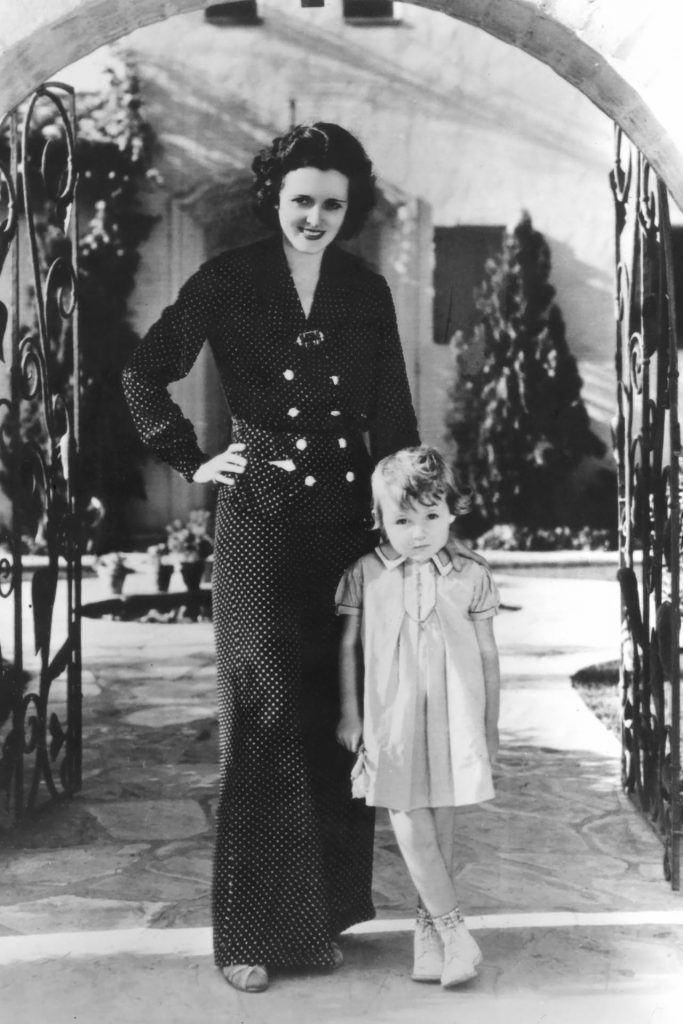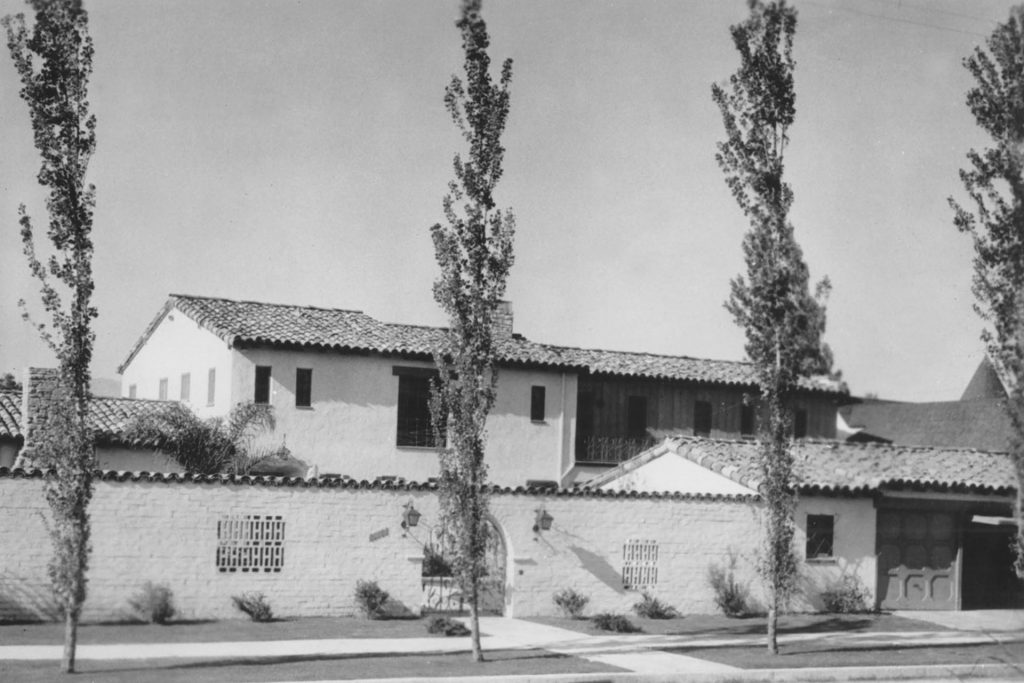
Bucolic Toluca Lake has entranced many celebrities over the years as the perfect place in which to raise kids, thanks to its small-town feel and proximity to motion picture studios. For Mary Astor, Frank Sinatra, Bobby Darin and Sandra Dee, one luxurious mansion on the shores of Toluca Lake offered the ideal spot to raise their families and set down roots. For all of them, their time there would be marked by both idyllic happiness and personal drama.

Popular screen queen Astor, best known for her roles in The Maltese Falcon and The Palm Beach Story, and her physician husband, Dr. Franklyn Thorpe, hunted larger quarters for their growing family after the birth of their daughter, Marylyn, in 1932. Finding nothing to their liking in the neighborhood surrounding their rental on Toluca Lake Avenue, the couple determined to construct a mansion just across the lake, near Astor’s work at Warner Bros. Studios.
Hiding their intentions, the couple pulled a building permit for a lot on Valley Spring Lane on August 8, 1933, under the name of Thorpe’s legal representative, Ethel Pepin (mistakenly written as Esther), listing the Hollywood Citizen newspaper’s office at 6362 Hollywood Blvd. as a current address. The Thorpes hired supermarket architect J.A. Murrey to design a stately two-story, pre-cast concrete Spanish Colonial home with a red tile roof and a picturesque front courtyard featuring a central fountain. The Los Angeles Times reported that the lakeside house cost $10,000, “one of the most ornate built in this section for several years.”
Keeping secrets was nothing new for the gorgeous Astor. Born Lucile Langhanke in 1906, the young woman had been homeschooled by her strict parents, who dictated her every move. A stage father from hell, Otto Langhanke pushed Lucile into show business at the age of 13. Paramount signed her to a movie contract and gave her the screen name Mary Astor. She received a small allowance from her large movie salary while her father pocketed the rest. It was not until Astor secretly married Thorpe in 1931 that she finally declared her independence from her parents.
The wedding to Thorpe came soon after the death of Astor’s first husband, Kenneth Hawks, in an airplane crash, and she quickly realized they made better companions than spouses. Fleeing her unhappy marriage for a New York vacation in 1935, the actress met famed playwright George S. Kaufman and began a torrid affair, which she documented in frank detail in her diary.

The book, however, was discovered and exploited by her angry, resentful husband (even though he had also had extramarital relationships himself), who leveraged it to coerce Astor into giving up custody of their daughter in exchange for a quick divorce. Growing tired of his blackmail, Astor battled to regain full custody of her daughter and her reputation in 1936, leading to a trial full of explosive testimony, a circus-like atmosphere and blistering diary excerpts. Astor testified during court sessions at night, while filming the movie Dodsworth during the day. Co-star Ruth Chatterton often accompanied her to court.
To observe Marylyn’s relationship with each of her parents, Superior Court Judge Goodwin Knight visited the Valley Spring Lane home in August 1936, throwing bread to the swans on the lake with the giggling 4-year-old while attempting to determine what would be best for her welfare. After weeks of hearings that made headlines nationwide, the judge awarded Astor custody of her daughter during the school year, and impounded the diary to the court’s care. Years later, Marylyn fondly remembered the Toluca Lake home and its peaceful lake view, calling it “a joy.”

Though divorced, Astor and Thorpe continued sharing the large home for some time due to depleted finances from the court fight. Astor added an open porch with a glass roof to the rear of the home in November of that year to better enjoy the lakeside view, one of her few pleasures at the time.
By 1940, glamorous Astor moved on. The Valley Spring Lane home changed hands twice before crooner Frank Sinatra purchased it in 1944 and relocated his family from the East Coast to Toluca Lake. Born in 1915 to Italian immigrants in Hoboken, New Jersey, the gangly, sweet-voiced young man started out with the Harry James and Tommy Dorsey big bands, then knocked the world off its feet as a solo performer before Metro-Goldwyn-Mayer signed him to a long-term movie contract. Sinatra starred in hit musicals Anchors Aweigh in 1945 and Till the Clouds Roll By in 1946, establishing a successful career on the West Coast.
The Sinatra children adored the Valley Spring Lane home. Nancy Sinatra enjoyed living “in that long pink house,” learning to ride her bike and roller-skate in the neighborhood with the other local children. In his free time, family man Sinatra kayaked, sailed, rowed and fished for trout in the lake, or swam across it with his kids.

Making the house a more lavish retreat, Sinatra upgraded much of the residence’s exterior and style, adding space and amenities. The singer removed the skylights from the back porch and added a composite roof, along with building the required California outdoor accessories: bath house, swimming pool and spa.
In her autobiography, Nancy recalled festive Fourth of July shindigs where the Sinatras entertained neighbors with barbecue and fireworks shows, orchestrated with music that she and Frank Jr. played from records. On one particular Independence Day, neighbors gathered around as Sinatra steered his fireworks-laden raft to the middle of the lake. Intending to impress the neighborhood with an enormous fireworks display, Sinatra inadvertently dropped a firecracker into the boat, setting off his entire stock in one gigantic explosion.
Nancy Sinatra also remembered animated parties filled with family and friends, enjoying downtime with her dad while eating rich Italian food prepared by her mother. Such celebrities as Jack Benny, George Burns and Gracie Allen, Phil Silvers and Sammy Cahn entertained themselves cracking jokes and singing the latest hits.
After meeting the sultry Ava Gardner in 1948, Sinatra moved out of the Toluca Lake house and into a West Hollywood apartment building, visiting his children on weekends. The singer shortened his commute even more when he purchased a Bel Air house in the late 1940s for his family, selling the lakeside retreat.
Ten years later, another ambitious Italian singer moved in. Born Walden Cassotto in 1936 in East Harlem, New Jersey, and afflicted with heart problems arising from rheumatic fevers he suffered as a child, the dapper singer/songwriter Bobby Darin soared up the charts with such hit songs as “Splish Splash,” “Mack the Knife” and “Beyond the Sea” in the late 1950s. Darin parlayed his celebrity into making successful television shows and movies.

With so little time, Darin moved fast. While on the set of his first major film, Come September, in 1960, Darin wooed virginal 16-year-old screen star Sandra Dee (born Alexandria Zuck), whom he married six months later. Dee’s innocent screen persona in films like Imitation of Life, Gidget and A Summer Place hid her personal trauma stemming from years of abuse by her stepfather. In 1961, Dee gave birth to a son with Darin, Dodd Mitchell.
Not long after, the couple moved to the house on Valley Spring Lane. Darin converted the old garage into a playroom for his son, and constructed a new garage to house their automobiles. Like other celebrity residents, the young couple loved the home’s close location to their work at nearby Universal Studios.
Cracks began appearing early in their marriage as Darin spent a majority of his free time headlining in Las Vegas, touring the country and making movies on the side. The clinging Dee turned to the bottle for solace, which further antagonized Darin.
The couple divorced in 1967, with Dee awarded the house in the property settlement. After both her marriage and her film career fell apart, she and young Dodd remained in Toluca Lake for several years before moving to the Beverly Hills area.
Expanded over the years, the estate on Valley Spring Lane has continued to welcome resident families with its stunning back view of the lake, stately gated front entrance and deep sense of history.
